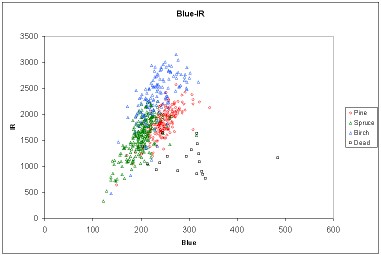| The STRS
method applied on MARV4/2 Introduction - Visual tree species interpretation By mapping the treetop 3D position we have an estimate for height (h), which has an accuracy that is also affected by the accuracy of the underlying DTM. Height alone is nearly useless for most applications unless it is combined with the species information that is fundamental for ecologic, economic and technical reasons. Tree species discrimination is not an easy task using remote sensing (RS). It is easy to enumerate cases, which are most likely unsolvable. For example, species in one genus form difficult cases. Think of species in the genera Abies, Picea, Betula, and Acer. Their discrimination can be difficult even in the field (Betula pendula vs. Betula pubescens; Abies sibirica vs. Abies balsamea). The species selection of natural forests increses towards warmer vegetation zones, which makes he application of STRS or RS more difficult in those conditions. In Finland, Scots pine, Norway spruce and Birch (incl. silver and downy birch) constitute 95 % of the total volume. In our compartment-based (metsikkötalousjärjestelmä) forestry the species selection of the planted trees is often known, which means that a priori information may be available for STRS. It may be possible that we can solve the species identification problem, but actually it still remains as a bottleneck for practical (automated) STRS applications, a problem that lacks decent solutions. Sensors: radiometry and geometry BW film is sensitive to the full spectrum of the visible light. The camera lens is usually equiped with a low-pass filter, that attenuates the UV light. Color film has three layers that have partially overlapping sensitivity curves that peak around 400 nm (blue), 550 nm (green) and 650 nm (red). CIR film has three layers that are all sensitive to the blue light, but have secondary peaks in their sensitivity near 550 nm (green sensitive layer), 650 nm (red) and 700-900 nm (NIR). Similarly, for reducing haze, the UV-light and the blue spectrum (all layers are sensitive to blue) are filtered by a yellow-filter, that blocks radiation at 500 nm and shorter wavelenghts. Color and CIR film are simplest forms of multispectral sensing. They have a high spatial resolution and moderate radiometric resolution. The geometric resolution is affected by the film grain (maximal resolution of the film), which is combined with the optical resolution of the lens system, when the film is exposed. When the sensor (camera) is taken to air, the resolution is further weakened by for example motion blurring unless it can be compensated for. The scale (distance to the object, focal lenght) then determines what is the resolution on ground. Hyperspectral sensors have a higher radiometric resolution, i.e. they can be used for measuring the reflectance from an object for several segments of the spectrum. However, the general rule is that in a sensor, the radiometric resolution and the geometric resolution go in reversed directions - they are compromises of each other. Further, when any film is digitized and quantized (scanned), both the radiometry and geometry are affected negatively. The geometric resolution determines the smallest details in the object (so-called inner scale) - crown in or case - that "we can see" in an image function. A ground sampling density (GSD) of 20 cm is needed - approximately - if the texture due to branches is wanted in the image function. Large pixels - e.g. 50 cm, result in mixed pixels, where a single pixel can contain parts of the crown that are in direct light and parts that are shaded. Crowns are always "fractal" 3D objects that are impossible to define unambiguosly. We can introduce concepts such as 'the crown envelope' in the 3D domain or 'crown area' in the images. These remain vague however. This is good to remember when we interprete the images. Separating the Finnish tree species Color Deciduous and coniferous trees differ in their reflectance properties in the NIR spectrum, where conifers reflect a lower portion of the light (Fig. 1). Fig 1. Blue × IR reflectance measured from an altitude of 900 m using Vexcel UltraCAM D aerial multispectral camera for classes of Pine, Spruce, Birch (broadleaved) and dead (spruce) trees. Observations apply to 28-cm pixels in the images near the 3D treetop positions. Fig 1. exemplifies what is meant by "overlapping features" - the 2D distributions for the four classes overlap. In practice it means that there will be errors made by an automatic classifier if the 2 spectral features (Blue, IR) will be used for discrimination. One of the major problems of image-based spectral species classification is not seen in Fig. 1. Aerial cameras and even linear scanners observe trees from an image-angle; some trees are seen from above and some are viewed from an oblique angle. The solar light that is reflected from the object consists mainly of direct light that comes from one direction. It does not reflect evenly in all directions by the reflectors (leaves, needles, bark, cones, epiphytes, flowers etc.) in a crown. The attitude of the reflectors in the crown affects how light reflects in diferent directions. Therefore that part of the crown, which is in direct light, does not produce the same reflectance values in the sensor - same pixel values for all pixels within the sun-lit crown - and, moreover, the same crown, when viewed from different directions is described by varying spectral (pixel) values. This adds a lot of complexity to the problem. |
Back to index,
Next
Texture: 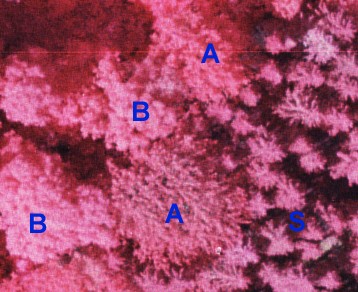
Fig 2. When the inner scale allows (here GSD=12
cm), it is possible to use texture for (visual) tree species discrimination.
Aspen (Populus tremula) has upright branches (A). The texture of birch crowns
(B) is smoother. Spruce (S), when seen from above, has a typical braching
pattern - however - depending on the morphology of the branches themselves
(Finnish terms 'laakaoksa', 'harjaoksa', 'kampaoksa') - the appearance can
vary considerably. In this figure, the scanned CIR film did not show significant
differenre in the NIR (scanned red 8-bit channel) values between the spruces
and the deciduous trees. Mature trees, h = 20-30 m.
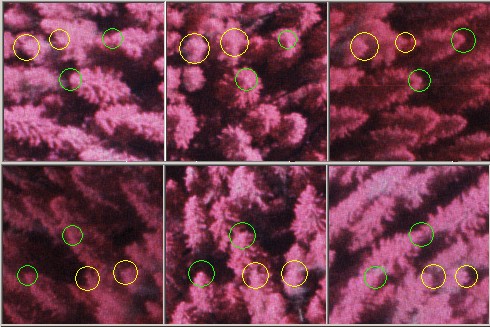
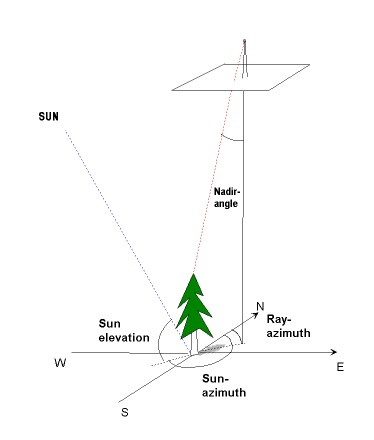
Fig. 3B. Each tree in the aerial photo is some
distance (nadir-angle) away from the center and either on the back-lit or
front-lit side of the image. These sides can further be devided into subsectors.
The example applies to a non-nadir, backlighted case. Image-object-sun geometry
of aerial photography.
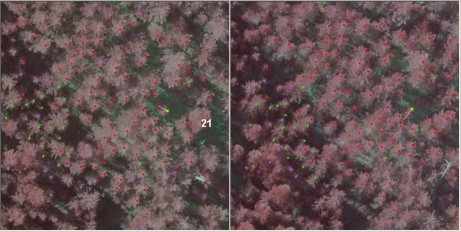
Fig 4. (Click to enlarge). An area of ca.
35 × 35 m seen in an image pair with 9 cm GSD. The colors denote species:
pine, spruce
and birch. Trees here are 25 years old and
the trees are 8-13 m high. The scale of the digital Vexcel images is 1:10000.
The pines have soft, blurred crowns. The difference in the blue spectrum
(Fig 1) is perhaps also helping the interpretation. Note that some trees
are hardly seen at all, for their detection, another set of images was used
in combination with this pair.
The same area as in Figure 4 can be viewed in different scales and on different film material: 1:6000 Color 2002, 1:6000 CIR 2002, 1:8000 CIR 2004, 1:12000 CIR 2002, 1:14000 CIR 2004, 1:16000 CIR 2002, 1:16000 BW 1999, 1:30000 CIR 2002. Crowns are observable in large scale (GSD < 20 cm) aerial images when their size is adequate, which is 1-2 m for the crown width (Dcrm), which is 4-7 m in height. Variation in the crown color and texture is not only due to the imaging geometry and the species, but consider also the following:
|
